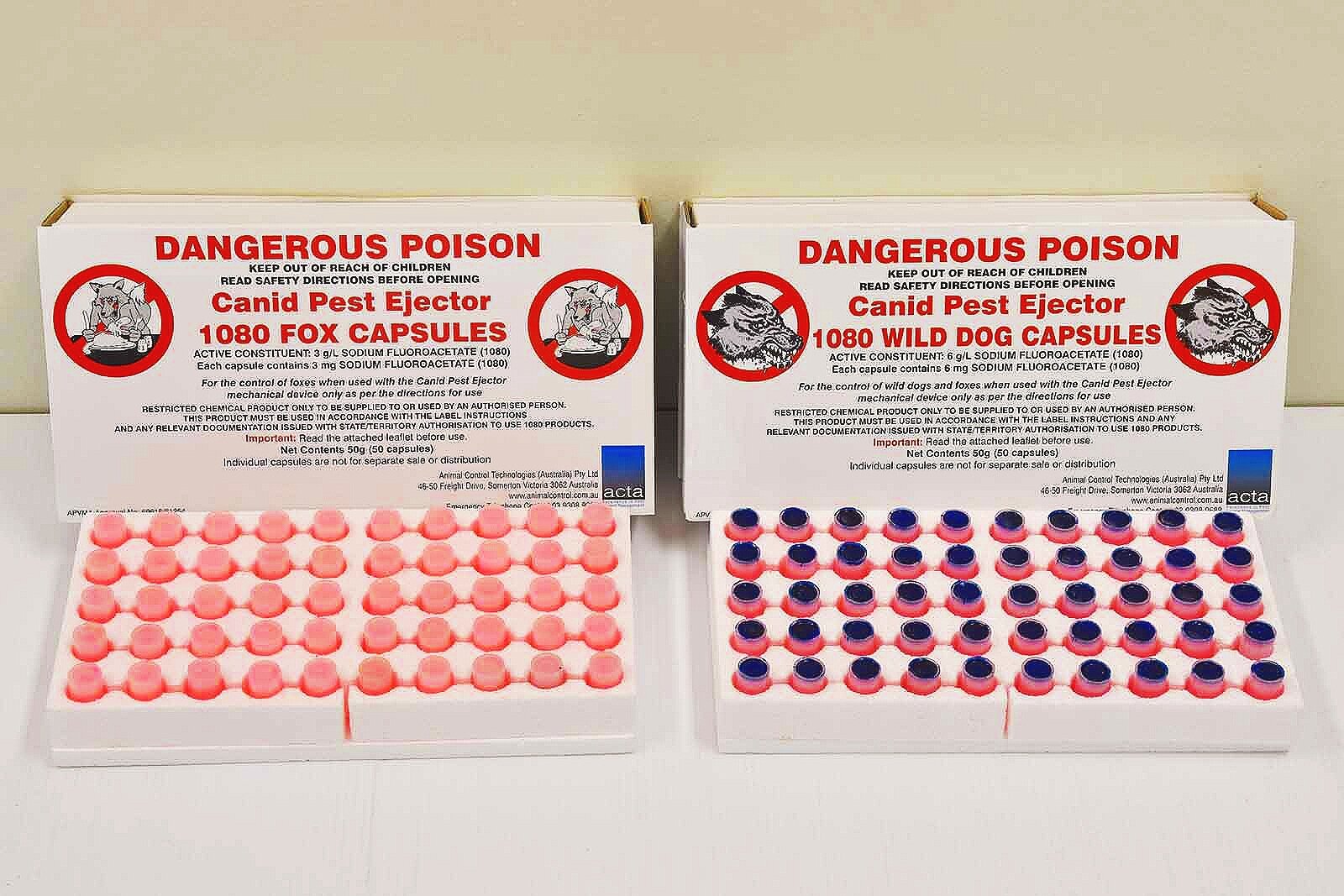Canid Pest Ejector (CPE)






Canid Pest Ejector (CPE)
Download: CPE Product Brochure
Download: PAPP Fox Capsule Directions for Use
Download: PAPP Wild Dog Capsule Directions for Use
Download: CPE 1080 Fox Capsule Product Label
Download: CPE 1080 Wild Dog Capsule Product Label
Download: CPE PAPP Fox Capsule (10) Product Label
Download: CPE PAPP Fox Capsule (50) Product Label
Download: CPE PAPP Wild Dog Capsule (10) Product Label
Download: CPE PAPP Wild Dog Capsule (50) Product Label
Watch video: ACTA Canid Pest Ejector - YouTube
Watch video: ACTA Candid Pest Ejector Presentation - YouTube
Canid Pest Ejectors (CPEs) were first developed in the USA in the 1930’s as a spring activated device for the control of coyotes. In the USA, the device was first called the ‘Humane Coyote Getter (HCG)’ and subsequently known as the ‘M-44’. Over many years they were adapted and improved to achieve the delivery of toxins directly into the mouth of a target animal. The spring activated ejector is not classified as a firearm by any agency.
CPE’s can be used with either 1080 or PAPP toxic capsules.
CPE Products & Accessories available
CPE Complete units (Ejector, Stake & Alloy or Plastic Capsule holder)
CPE Full training kit (1, 3 or 5 CPE units included)
Individual CPE Components (Ejector, Stake, Alloy Capsule holder, Spiked Plastic Capsule holder)
CPE Dried meat lures (10 pack Kangaroo or Venison)
Various CPE Accessories & Parts (Setting pliers, Setting tube, Plunger, Plunger O-Ring, Trigger, Spring, Bottom Pin, Stake Ring)
CPE 6mg 1080 Capsules for Wild Dogs (10 or 50 pack)
CPE 3mg 1080 Capsules for Foxes (10 or 50 pack)
CPE 1000mg PAPP capsules for Wild Dogs (10 or 50 pack)
CPE 400mg PAPP capsules for Foxes (10 or 50 pack)
CPE Non-toxic Capsules (50 pack)
CPE Corn meal demonstration Capsules (50 pack)
CPE Pepper Dog training Capsules (50 pack)
Features of the device
The firm upward pulling action required to trigger the poison delivery, is easily achieved by foxes and wild dogs, but much less so by most non-target species
Target specificity is further enhanced by the use of lure heads that do not attract herbivores
Target specificity is further enhanced by the use of lure heads that do not attract herbivores
The toxins used, either sodium fluoroacetate (‘1080’) or PAPP are highly toxic to canid pests (foxes & wild dogs)
Birds and reptiles are rarely able to trigger the device even if they show interest in the lure
The device is staked to the ground by a sturdy metal peg and cannot be easily moved
Devices may be set and left in place for extended periods (subject to local regulations) and can thus be used in long-term management programs
The CPE device has been extensively tested in Victoria, New South Wales and Queensland to deliver a variety of potential toxins
Benefits of ejectors
The field trials also confirmed a number of benefits that make ejectors suitable for use as an additional wild dog and fox control tool:
Ejector capsules containing 1080 or PAPP are sealed and protected from the elements so that the toxicant remains viable for extended periods in the field. Therefore the ejector can be set and left in the field for extended periods to provide a sentinel station, so long as the bait head remains attractive to target species.
CPE devices are pinned to the ground so they cannot easily be moved or cached by foxes, wild dogs or birds
Once set, a CPE is only activated by a direct pull on the lure head that activates the spring loaded plunger to propel the contents of the capsule directly into the mouth of the wild dog or fox
As the ejector can only be activated by an animal with an upward pull force of >1.6kg, many small non–target animals are excluded from activating ejectors. Researchers in Victoria identified that “only red foxes, wild dogs and feral cats had been recovered in field trials when cyanide was used as the active agent, suggesting a high level of target specificity” (Busana et al. 1998; Marks et al. 2003).
NSW Office of Environment and Heritage (OEH) trials used monitored sand plots, remote triggering cameras and carcass collection to assess non-target risks after the use of cyanide (quick kill) capsules on 100,000 exposure nights. Few non-target activations were recorded despite many non-target animals being observed within close proximity to the devices.
Ejectors can be re-used many times.
Only 5 brush-tail possum carcasses were retrieved despite remote cameras recording 171 occasions where a brush-tail possum was present within 3m of a cyanide ejector during a total of 10,520 cyanide night exposures. Thus only 2.9% of brush-tail possum visits to ejectors resulted in activation. Long-term monitoring of sandplot activity on transects where 1080 ejectors were continually deployed over 5 years, identified brush-tail possum activity remaining stable or increasing. Thus no population impact on this non-target was recorded when using 1080 ejectors.
Lethal activations were recorded for only one goanna (from 1,050 cyanide exposure nights) and one swamp wallaby (from 3,510 cyanide nights). Remote cameras identified 315 occasions where a swamp wallaby was present within 3m of a cyanide ejector with only one lethal outcome. Neither non-target would be affected by the 1080 or PAPP dose used for control of foxes or wild dogs.
The combination of a low probability of activating an ejector, low non–target attraction to lure heads and greater tolerance to 1080 suggests that 1080 delivered through the Canid Pest Ejector will have minimal population–level impacts on native species.
Limitations of ejectors
Ejector devices are only effective while the bait head is attractive to the target species. If the bait head deteriorates, the ejector is less likely to be activated by a wild dog or fox. It is therefore important to check ejector heads periodically and to refresh any lure heads that are weathered, damaged or eaten by ants.
Ejectors are dangerous to working and domestic dogs because of the attractiveness of the baited head. Any unrestrained or roaming working or pet dog in the area may investigate and may activate an ejector.
Use of muzzles prevents dogs from activating CPEs.
How do I purchase this product?
For all ACTA products, the most efficient way to purchase what you need is to contact your local rural merchant store and ask for our products - our main distributors are listed here.
For products that contain 1080 or PAPP, regulations vary between States & Territories.
If you are in NSW, contact your regional Local Land Services (LLS).
If you are in South Australia, contact you regional Landscape Boards.
All other areas should be able to access products directly from your local rural merchant store.
Contact us for more information if required and we can advise you on the best way forward.
